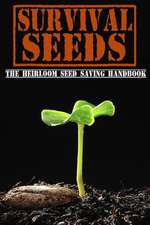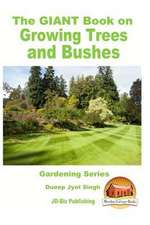The Complete Book of Bonsai: A Practical Guide to Its Art and Cultivation
Autor Harry Tomlinsonen Limba Engleză Hardback – 28 feb 1991
CLASSIC STYLES EXPLAINED
The origins and development of bonsai are traced, and the underlying principles of this fascinating art clearly explained. The classic styles are listed and illustrated, together with full descriptions of how they were derived from models in the world. Outstanding examples of plantings in all of the various styles are shown. The types of containers are detailed, and the importance of their use for different trees or styles explained. Advice is given on placing and exhibiting your completed bonsai.
CLEAR STEP-BY-STEP SEQUENCES
There is comprehensive information on how to create a bonsai from a seedling, cutting, or garden center plant. Clear step-by-step sequences take you from the initial raw material through to the finished bonsai, showing the superb results that can be achieved. All the tools and techniques of bonsai are illustrated and explained, and their use described in detail. Maintenance and propagation sections tell you everything you need to know to keep your bonsai beautiful and healthy, or to create your own trees.
DETAILS OF MORE THAN 100 SPECIES
A photographic catalogue of bonsai trees and shrubs lies at the heart of the book, providing the cultivation and styling details of over 100 different species. Each entry is accompanied by an original full-color photograph of at least one outstanding specimen. This section is supplemented by a further compendium of trees and shrubs that can be grown as bonsai, giving a total of over 300 to choose from.
The Complete Book of Bonsai reveals every aspect of the art, with inspirational ideas and practical advice at every turn. Whether you are a beginner who would like to grow just one or two trees, or an experienced enthusiast who wishes to build up a whole collection, it is the essential reference work.
The origins and development of bonsai are traced, and the underlying principles of this fascinating art clearly explained. The classic styles are listed and illustrated, together with full descriptions of how they were derived from models in the world. Outstanding examples of plantings in all of the various styles are shown. The types of containers are detailed, and the importance of their use for different trees or styles explained. Advice is given on placing and exhibiting your completed bonsai.
CLEAR STEP-BY-STEP SEQUENCES
There is comprehensive information on how to create a bonsai from a seedling, cutting, or garden center plant. Clear step-by-step sequences take you from the initial raw material through to the finished bonsai, showing the superb results that can be achieved. All the tools and techniques of bonsai are illustrated and explained, and their use described in detail. Maintenance and propagation sections tell you everything you need to know to keep your bonsai beautiful and healthy, or to create your own trees.
DETAILS OF MORE THAN 100 SPECIES
A photographic catalogue of bonsai trees and shrubs lies at the heart of the book, providing the cultivation and styling details of over 100 different species. Each entry is accompanied by an original full-color photograph of at least one outstanding specimen. This section is supplemented by a further compendium of trees and shrubs that can be grown as bonsai, giving a total of over 300 to choose from.
The Complete Book of Bonsai reveals every aspect of the art, with inspirational ideas and practical advice at every turn. Whether you are a beginner who would like to grow just one or two trees, or an experienced enthusiast who wishes to build up a whole collection, it is the essential reference work.
Preț: 293.40 lei
Nou
Puncte Express: 440
Preț estimativ în valută:
56.17€ • 58.61$ • 47.08£
56.17€ • 58.61$ • 47.08£
Carte disponibilă
Livrare economică 19 februarie-05 martie
Preluare comenzi: 021 569.72.76
Specificații
ISBN-13: 9781558591189
ISBN-10: 1558591184
Pagini: 224
Dimensiuni: 229 x 279 x 20 mm
Greutate: 1.25 kg
Editura: Abbeville Publishing Group
Colecția Abbeville Press
ISBN-10: 1558591184
Pagini: 224
Dimensiuni: 229 x 279 x 20 mm
Greutate: 1.25 kg
Editura: Abbeville Publishing Group
Colecția Abbeville Press
Cuprins
Foreword PAGES 6-7
Introduction PAGES 8-11
CHAPTER ONE The Art of Bonsai PAGES 12-43
CHAPTER TWO Creating a Bonsai PAGES 44-89
CHAPTER THREE Bonsai Species Guide PAGES 90-167
CHAPTER FOUR Routine Maintenance PAGES 168-181
CHAPTER FIVE Propagation Techniques PAGES 182-189
CHAPTER SIX Compendium of Trees and Shrubs for Bonsai PAGES 190-217
Glossary of Terms PAGES 218-219
Index PAGES 220-223
Acknowledgments PAGE 224
Introduction PAGES 8-11
CHAPTER ONE The Art of Bonsai PAGES 12-43
CHAPTER TWO Creating a Bonsai PAGES 44-89
CHAPTER THREE Bonsai Species Guide PAGES 90-167
CHAPTER FOUR Routine Maintenance PAGES 168-181
CHAPTER FIVE Propagation Techniques PAGES 182-189
CHAPTER SIX Compendium of Trees and Shrubs for Bonsai PAGES 190-217
Glossary of Terms PAGES 218-219
Index PAGES 220-223
Acknowledgments PAGE 224
Recenzii
"This is the most thorough, lavishly...illustrated book any bonsai enthusiast could wish for, written with clarity and inspiration by one of Europe's leading experienced authorities." —Choice
"The authors passion for his subject is communicated on every page." —Elle Decor
"The photographs alone are worth the purchase price." —The Sacramento (Calif.) Bee
"The authors passion for his subject is communicated on every page." —Elle Decor
"The photographs alone are worth the purchase price." —The Sacramento (Calif.) Bee
Notă biografică
Harry Tomlinson is one of Europe's leading bonsai artists and instructors. He has been both studying and practicing the principles of bonsai for almost thirty years, and is an internationally recognized authority on the subject. He has exhibited bonsai and gained awards in Britain and Japan, and has judged the bonsai section at Britain's world-famous Chelsea Flower Show. For the past thirteen years the author has been a professional bonsai artist with his own studio, and is a leading bonsai nurseryman. Greenwood Bonsai Studio, which he runs with his wife Christine, is the largest and most complete bonsai nursery in Britain.
Elvin McDonald, who wrote the Foreword, is Director of Special Projects at the Brooklyn Botanic Garden.
Elvin McDonald, who wrote the Foreword, is Director of Special Projects at the Brooklyn Botanic Garden.
Extras
Introduction
I am often asked when it was and why that I first became attached to bonsai. My earliest recollection dates back to a rainy holiday around 1950 spent visiting my aunt and uncle. I would like to be able to say that they employed a scholarly, kind, elderly Japanese gardener who entrusted me with the ancient oriental secrets of bonsai culture and set me on a path of spiritual enlightenment. However, the truth is more prosaic. Out of boredom, kept indoors by the wet weather, and being an avid and compulsive reader of everything from cereal packets to the complete works of Charles Dickens, I started on the only reading matter in the house – a set of rather decrepit encyclopedias. Luckily, the rain lasted for several days, long enough for me to complete the As and most of the Bs (for many years I was a child prodigy on any subject from A to B).
The only distinct impression I retain from this industrious study is that of bonsai. My imagination was stirred, and for weeks my parents had to contend with plant pots full of seed and saplings on windowsills all around the house. I scoured the local library for any more information about bonsai, without success. The initial interest, without further fuel, subsided.
About ten years later, I came across "The Japanese Art of Trees and Landscapes" by Yuji Yoshimura and Giovanna M. Halford (first published by Charles E. Tuttle in 1957 and still a valued work, with its thirty-first printing in 1987, this was the first major book on bonsai published in English), and the flame of my earlier interest was rekindled and I was soon addicted. As the interest in bonsai in the West grew, more and more books in English became available and I bought and studied every one. Gradually but inevitably, bonsai took over my life – to such an extent that in 1979 I resigned, after almost twenty years, my executive post in the Civil Service to devote my life to bonsai.
I am often asked when it was and why that I first became attached to bonsai. My earliest recollection dates back to a rainy holiday around 1950 spent visiting my aunt and uncle. I would like to be able to say that they employed a scholarly, kind, elderly Japanese gardener who entrusted me with the ancient oriental secrets of bonsai culture and set me on a path of spiritual enlightenment. However, the truth is more prosaic. Out of boredom, kept indoors by the wet weather, and being an avid and compulsive reader of everything from cereal packets to the complete works of Charles Dickens, I started on the only reading matter in the house – a set of rather decrepit encyclopedias. Luckily, the rain lasted for several days, long enough for me to complete the As and most of the Bs (for many years I was a child prodigy on any subject from A to B).
The only distinct impression I retain from this industrious study is that of bonsai. My imagination was stirred, and for weeks my parents had to contend with plant pots full of seed and saplings on windowsills all around the house. I scoured the local library for any more information about bonsai, without success. The initial interest, without further fuel, subsided.
About ten years later, I came across "The Japanese Art of Trees and Landscapes" by Yuji Yoshimura and Giovanna M. Halford (first published by Charles E. Tuttle in 1957 and still a valued work, with its thirty-first printing in 1987, this was the first major book on bonsai published in English), and the flame of my earlier interest was rekindled and I was soon addicted. As the interest in bonsai in the West grew, more and more books in English became available and I bought and studied every one. Gradually but inevitably, bonsai took over my life – to such an extent that in 1979 I resigned, after almost twenty years, my executive post in the Civil Service to devote my life to bonsai.













